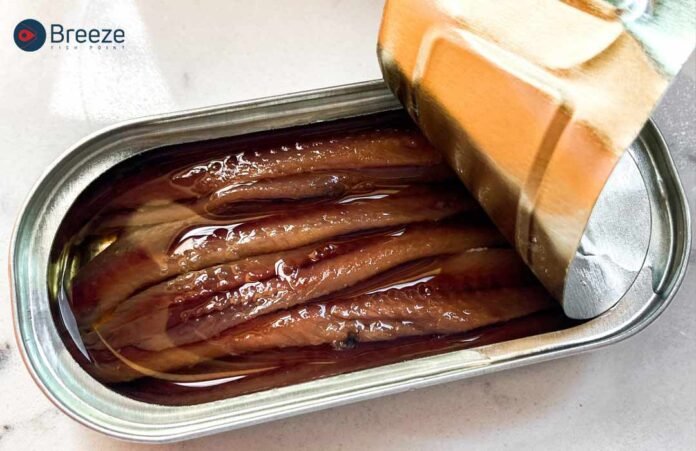What Are Anchovies?
Anchovies are small schooling fish from the family Engraulidae, with more than 140 types of fish recognized. They are exclusively marine, though most species are native to the Mediterranean Sea and other parts of the Atlantic coast. However, some species are known to live in freshwater. Anchovies are generally small fish that measure between 2 to 6 inches in length; despite their small size, anchovies are of great importance in providing food and nutrients to the world.
The meat is oily; therefore, these fish are usually processed through canning or cured through salting. Raw anchovies are relatively less salty and are often used in Mediterranean cuisine. However, the naturally preserved form, which involves salting the fish and packaging them in oil or brine, enhances their taste and gives those canned anchovies the strong, savory aroma that is well-known in dishes.
Why Do Anchovies Look Angry?
It is not a secret that the appearance of anchovies is rather provocative, and people often joke that they are ‘mad fishes.’ Their lips are slightly drooping down, especially at the corners, and their faces are pointed, giving them the look of a constant frown. This characteristic look, however, is simply due to their natural build and does not indicate anything about their temper.
Even though they have rather menacing looks, anchovies are about as harmless as you can get: they are small fish that tend to school together in large numbers. They are not territorial, and they do not attack people or other animals. Despite their unassuming appearance, anchovies play an essential role in ecosystems and food chains. Some of the biggest fish, seabirds, and other marine mammals feed primarily on anchovies. Additionally, fish oil derived from anchovies is highly valued for its omega-3 fatty acids, contributing to its importance in marine ecosystems and human nutrition.
Canned Anchovies in Cooking
Actively and widely used in our diet, anchovies are mostly consumed through canned anchovies. This is a small fillet of anchovy that is usually prepared with salt and normally stored in oil or water. The curing process makes anchovies have a salty and umami taste, which is why the fish is common in most kitchens. Anchovies are preserved by canning in small metal cans or tin containers, and their applications are common in households and restaurants globally.
Whether you’re making a traditional dish like jhinga or experimenting with new recipes, anchovies in a tin can be relied upon to provide that burst of salt or that rich, meaty flavor to meals. Ranging from sauces and dressings to pizzas, pasta, and everything in between, a canned anchovy is a special ingredient in any recipe. The same is true of a couple of fillets of anchovies simmered in olive oil, which, when blended, form the base of a pasta sauce or chopped-up anchovies in salad dressings.
Choosing the Best Anchovy Can
Anchovies are available in different forms whenever you go shopping for fish in any market. Some are even skinned and boned and packed in olive oil, while the others can be whole, cured in salt, or even mashed to become anchovy paste. Here are a few tips to help you choose the best anchovy can for your needs:
- Filleted Anchovies:
Canned anchovies are seen in two forms, and the one described here is the most traditional type of canned anchovies. They are easy sculpture cheese and are ideally used when melted for garnishing on pizzas or additions to salads.
- Whole Anchovies:
The whole anchovy for increased flavor is available and is commonly preserved with salt thus you get a much stronger taste. They need some processing like; filleting and soaking for a certain period to help reduce the content of salt in fish.
- Anchovy Paste:
Anchovy paste is a preparation done by reducing filleted anchovies into a paste through grounding. Even better for recipes for which you want that anchovy flavor but don’t have the time or stomach for fillets.
Again, when purchasing this fish, always read the label on the can to find out the quality of the fish you are using. Canned anchovies in olive oil, as a rule, taste better than in cheap vegetable oils, and if the anchovies are prepared with classic techniques, the taste will be even better.
Anchovy Recipes:
Anchovies are an extremely useful product in the kitchen, they can be unobtrusive steps or deliberately add spicy notes to a dish. They add lots of robust flavor to foods, especially in Mediterranean and Italian meals, despite coming in small packages. Here are some popular anchovy recipes that showcase the power of this tiny fish:
Pasta Puttanesca:
The Italians are great lovers of food and wine, and this dish is typical of this country which incorporates red olives and anchovies fish escalops, fried is formed by capers, garlic, tomato, and olive oil. The anchovies disappear in the sauce: it simply thickens around the aromatic base and the governing flavor.
Caesar Salad Dressing:
For a taste of a true Caesar dressing you don’t just need lettuce, but it also requires anchovies. It’s quite simply anchovy fillets or pastes, giving this dressing its deep, savory.
Bagna Cauda:
A common Italian sauce that is prepared with garlic, olive, and anchovy fish. It is prepared hot, and it is taken with fresh assorted vegetables or bread.
Health Benefits of Anchovies
- Rich in omega-3 fatty acids for heart health, inflammation control, and brain performance improvement.
- High in proteins, calcium, and B12 vitamins, making them suitable for increased fish meal intake.
- Low mercury levels, making them suitable for regular consumption, especially for pregnant or breastfeeding women.




